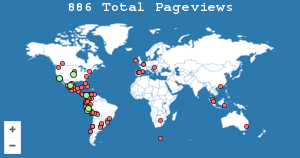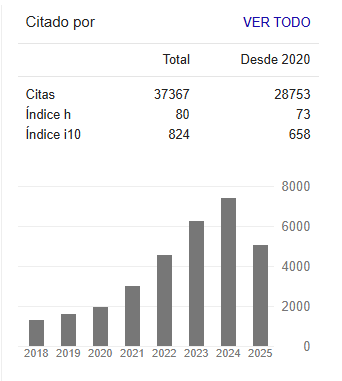Creativity and disruptive innovation in entrepreneurial intention: Mexico and Spain
Resumen
This paper analyzes the influence of creativity and disruptive innovation on entrepreneurial intention, considering the subjective social norms and personal attitude of the Theory of Reasoned Action, and through a structural equation model. The empirical study was applied to a sample of potential entrepreneurs in two countries: Mexico and Spain, to identify behavioral actions within the relationships of the proposed model. The main results obtained indicate that entrepreneurial intention is influenced by personal attitude towards entrepreneurship, which in turn is shaped by subjective social norms, and by the self-perception of their creative abilities. While Mexican present a greater relationship with the influence of entrepreneurial attitude on entrepreneurial intention, Spanish entrepreneurs are more confident in their creative abilities to develop their projects. It is concluded, that there is a need to develop communication and training campaigns aimed at Mexican and Spanish society to promote a better opinion of the entrepreneurial process as well as to generate actions to develop and include creativity and disruptive innovation as part of the entrepreneurial process.
Citas
Ajzen, I. (2002). Perceived behavioral control, self-efficacy, locus of control, and the theory of planned behavior. Journal of Applied Social Psychology, 32(4), 665-683.
Ajzen, I. (2005). Attitudes, personality and behavior (2nd ed.). London: Open University Press.
Aldrich, H. E., & Martinez, M. A. (2001). Many are called, few are chosen: An evolutionary perspective for the study of entrepreneurship. Entrepreneurship Theory and Practice, 25, 41–56.
Amestoy, M. (1991). Desarrollo de habilidades de pensamiento: Creatividad. Trillas.
Baer, M. (2012). Putting creativity to work: The implementation of creative ideas in organizations. Academy of Management Journal, (55), 1102-1119.
Bilton, C. (2007). Management and creativity: From creative industries to creative management. Blackwell Publishing.
Bosma, N. S., & Schutjens, V. (2011). Understanding regional variation in entrepreneurial activity and entrepreneurial attitude in Europe. The Annals of Regional Science, 47(3), 711-742.
Bower, J.L., & Christensen, C.M. (1995). Disruptive technologies: Catching the wave. Harvard Business Review, 73(1), 43–53.
Calanchez Urribarri, A., Chavez Vera, K., Reyes Reyes, C., & Ríos Cubas, M. (2022). Desempeño innovador para el fortalecimiento de la cultura de emprendimiento en Perú. Revista Venezolana De Gerencia, 27(100), 1837-1858. Recuperado a partir de https://produccioncientificaluz.org/index.php/rvg/article/view/38884
Choo, S., & Wong, M. (2006). Entrepreneurial intention: Triggers and barriers to new venture creations in Singapore. Singapore Management Review, 28(2), 47-64.
Christensen, C.M. (1997). The innovator’s dilema: When new technologies cause grat firms to fail. Boston (MA): Harvard Business School Press.
Christensen, C.M., Raynor, M., & McDonald, R. (2015). Whats is disruptive innovation? Harvard Business Review, 93(12): 44-53.
Cohen, J. (1998). Statistical power analysis for the behavioral sciences, 2a. edition. Hilsdale (NJ): Lawrence Erlbaum Associates.
Comeche J.M., & Pascual, J.V. (2014). Communicating knowledge vs. organising knowledge: The use of gen-preneur in class. Journal of Technology Management & Innovation, 9(3), 146-157.
Dabale, W.P, & Masese, T. (2014). The influence of entrepreneurship education on beliefs, attitudes and intentions: A cross-sectional study of Africa University graduates. European Journal of Business and Social Sciences, 3(9), 1-13.
Dyer, J.H., Gregersen, H.B., & Christensen, C.M. (2011). The innovator’s DNA: Mastering the five skills of disruptive innovators. Boston (MA): Harvard Business School Press.
Faul, F., Erdfelder, E., Buchner, A., & Lang, A.-G. (2009). Statistical power analyses using G*Power 3.1: Tests for correlation and regression analyses. Behavior Research Methods, 41, 1149-1160.
Fillis, I., & Rentschler, R. (2010). The role of creativity in entrepreneurship. Journal of Enterprising Culture, 18(1), 49-81.
Fishbein, M., & Ajzen, I. (1975). Belief, attitude, intention, and behavior. Reading (MA): Addison-Wesley.
Flores-Novelo, A., Bojórquez Carrillo, A. L., & Cuadrado Barreto, G. C. (2021 Driving and restraining forces of female latin american entrepreneurship. Telos: revista de Estudios Interdisciplinarios en Ciencias Sociales, 23(3), 668-691. https://doi.org/10.36390/telos233.11
Formichella, M.M., & Massigoge, J.I. (2004). El concepto de emprendimiento y su relación con el empleo, la educación y el desarrollo local [Conferencia]. VII Congreso Nacional e Internacional de Administración, Buenos Aires, Argentina.
Frederiksen, M.H., & Knudsen, M.P. (2017). From creative ideas to innovation performance: The role of assessment criteria. Creativity and Innovation Management, 26(1), 60-74. https://doi.org/10.1111/caim.12204
George, J.M. (2007). Creativity in organizations. Academy of Management Annals, (1), 439-477. https://doi.org/10.1080/078559814
Guerrero, M., Rialp, J., & Urbano, D. (2008). The impact of desirability and feasibility on entrepreneurial intentions: A structural equation model. International Entrepreneurship and Management Journal, 4(1), 35-50. https://doi.org/10.1007/s11365-006-0032-x
Hansemark, O. (2003). Need for achievement, locus of control and the prediction of business start-ups: A longitudinal study. Journal of Economic Psychology, 24(3), 301-319. https://doi.org/10.1016/S0167-4870(02)00188-5
Kabukcu, E. (2015). Creativity process in innovation oriented entrepreneurship: The case of Vakko. Procedia – Social and Behavioral Sciences, 195, 1321-1329. https://doi.org/10.1016/j.sbspro.2015.06.307
Liñán, F., & Chen, Y.W. (2009). Development and cross-cultural application of a specific instrument to mesure entrepreneurial intentions. Entrepreneurship Theory & Practice, 33(3), 593-617. https://doi.org/10.1111/j.1540-6520.2009.00318.x
Lowe, R., & Marriott S. (2006). Enterprise: Entrepreneurship and innovation concepts, contexts and commercialization. BH (Butterworth-Heinemann) of Elsevier.
Markman, GD, Balkin, DB & Baron, RA (2002). Inventors and new venture formation: The effects of general self-efficacy and regretful thinking. Entrepreneurship Theory and Practice, 27(2), 149–165. https://doi.org/10.1111/1540-8520.00004
Martínez-Fierro, S., Biedma-Ferrer, J.M. & Ruíz-Navarro, J. (2015). Las condiciones del entorno emprendedor y el desarrollo económico: Un análisis de los países GEM. Revista de Economía Mundial, 41, 181-212. https://www.redalyc.org/articulo.oa?id=86643415008
Markman, G., & Baron, R. (2003). Person entrepreneurship fit: Why some people are more successful as entrepreneurs than others. Human Resource Management Review, 13(2), 281-301. https://doi.org/10.1016/S1053-4822(03)00018-4
Nabi, G., Holden, R., & Walmsley, A. (2006). Graduate career-making and business start-up: A literature review. Education+Training, 48(5), 373-385. https://doi.org/10.1108/00400910610677072
Ozaralli, N., & Rivenburgh, N.K. (2016). Entrepreneurial intention: Antecedents to entrepreneurial behavior in the USA and Turkey. Journal of Global Entrepreneurship Research, 6(3), 1-32. https://doi.org/10.1186/s40497-016-0047-x
Quezada, M. E., Vega-Valero, C. Z., y Nava-Quiroz, C. (2021). Evaluación de las competencias genéricas del comportamiento emprendedor. Retos Revista de Ciencias de la Administración y Economía, 11(22), 301-314. https://doi.org/10.17163/ret.n22.2021.07
Quispe Fernandez, G. M., Delgado Ayaviri, R., Ayaviri Nina, D., & Maldonado Núñez, A. I. (2022). Competencias emprendedoras para generar una cultura de emprendimiento en la educación superior. Revista De Ciencias Sociales, 28, 297-313. https://doi.org/10.31876/rcs.v28i.38847
Ringle, C. M., Wende, S., & Becker, J. M. (2015). SmartPLS 3. Boenningstedt: SmartPLS GmbH. http://www.smartpls.com
Rueda, I., Fernández-Laviada, A., & Herrero, A. (2013). Aplicación de la teoría de la acción razonada al ámbito emprendedor en un contexto universitario. Investigaciones Regionales, 26, 141-158. https://www.redalyc.org/articulo.oa?id=28928246007
Sabah, S. (2016). Entrepreneurial Intention: Theory of Planned Behaviour and the Moderation Effect of Start-Up Experience. In (Ed.), Entrepreneurship - Practice-Oriented Perspectives. IntechOpen. https://doi.org/10.5772/65640
Salazar, P.F., Herrera I.M., Rueda, S., & León, J.M. (2014). El efecto de la conservación de recursos sobre la intención emprendedora en el contexto de crisis económica: El rol moderador de la autoeficacia y la creatividad. Anales de Psicología, 30(2), 549-559. https://dx.doi.org/10.6018/analesps.30.2.159281
Schmidt, J., Soper, J., & Facca, T. (2012). Creativity in the entrepreneurship classroom. Journal of Entrepreneurship Education, 15(1), 123-132.
Schumpeter, J. (1934). The theory of economic development. Boston (MA): Harvard University Press.
Schwarz, R. (2015). What the research tell us about team creativity and innovation. Harvard Business Review, 15. https://hbr.org/2015/12/what-the-research-tells-us-about-team-creativity-and-innovation
Shalley, C.E., Hitt, M.A., & Zhou, J. (Eds.) (2015). The Oxford handbook of creativity, innovation, and entrepreneurship. Oxford University Press.
Stewart, W.H., Watson, W.E., Carland, J.C., & Carland, J.W. (1999). A productivity for entrepreneurship: A comparison of entrepreneurs, small business owners, and corporate managers. Journal of Business Venturing, 14(2), 189-214. https://doi.org/10.1016/S0883-9026(97)00070-0
Torres, F., & Meleán, R., (2021). Emprendedores venezolanos: reconstrucción de visiones ante nuevas realidades. Revista Científica Electrónica de negocios, 49(17), 5-19. http://doi.org/10.5281/zenodo.4765238
Tsordia, C., & Papadimitriou, D. (2015). The role of theory of planned behavior on entrepreneurial intention of Greek business students. International Journal of Synergy and Research, 4(1), 23-37. http://dx.doi.org/10.17951/ijsr.2015.4.1.23
Vanevenhoven, J., & Liguori, E. (2013). The impact of entrepreneurship education: Introducing the entrepreneurship education project. Journal of Small Business Management, 51(30), 315-328. https://doi.org/10.1111/jsbm.12026
Vigotsky, L. (1981). The genesis of higher mental funtions. In J.V. Wertsch (Ed.), The concept of activity in soviet psychology. Sharpe.
Wijbenga, F., & van Witteloostuijn, A. (2007). Entrepreneurial locus of control and competitive strategies: The moderating effect of environmental dynamism. Journal of Economic Psychology, 28, 566-589.
Zampetakis, L.A., Moustakis, V., Dewett, T. & Zampetakis, K. (2011). A longitudinal analysis of students’ creativity scripts. Journal of Creative Behavior, 42(4), 237-254.
Zhao, H., Seibert, S., & Lumpkin, G. (2010). The relationship of personality to entrepreneurial intentions and performance: A meta-analytic review. Journal of Management, 36(2), 381-404. https://doi.org/10.1177/0149206309335187
Zhou, J., & George, J. M. (2001). When job dissatisfaction leads to creativity: Encouraging the expression of voice. Academy of Management Journal, 44(4), 682-696. https://doi.org/10.2307/3069410
Zhou, J., & Shalley, C.E. (2011). Deepening our understanding of creativity in the workplace: A review of different approaches to creativity research. In S. Zedeck (Ed.), APA handbook of industrial ans organizational psychology. Vol. 1: Building ans developing the organization [pp. 275-302]. Whashington, DC: American Psychologycal Association.

Esta obra está bajo licencia internacional Creative Commons Reconocimiento-NoComercial-CompartirIgual 4.0.








.png)






























